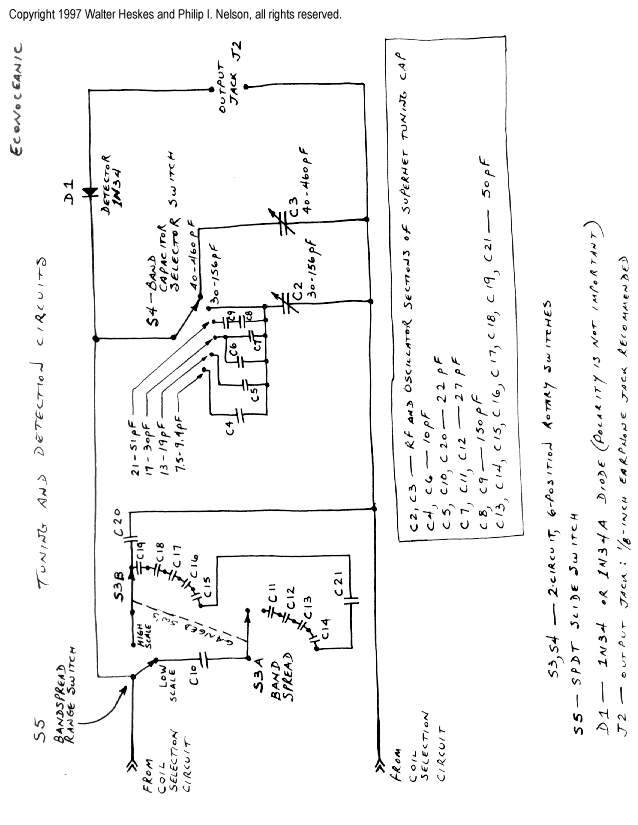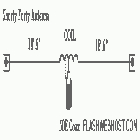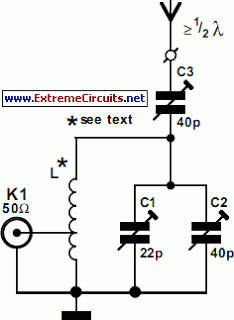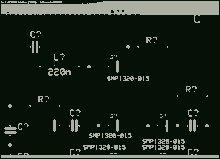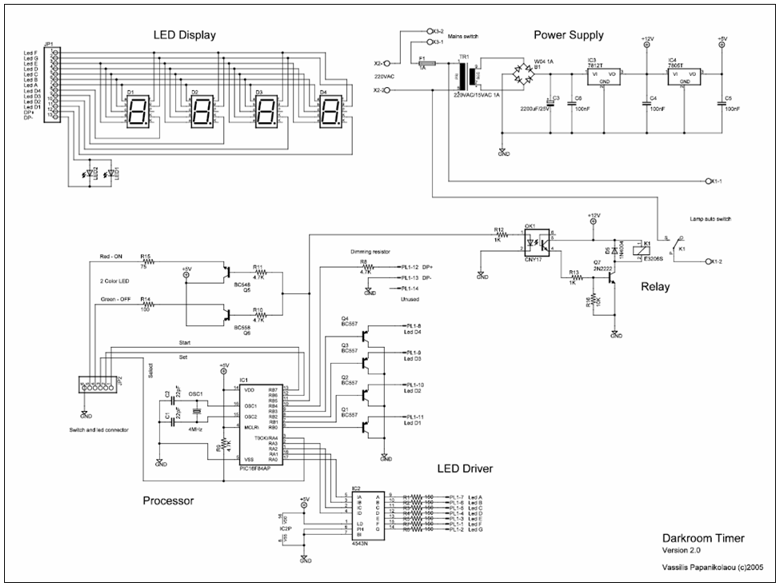
Active Shortwave Antenna PCB
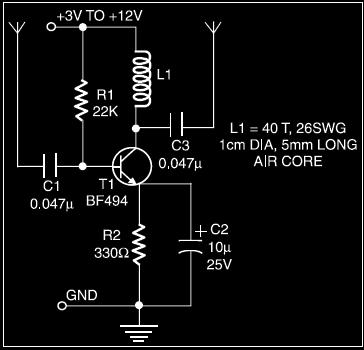
The circuit of an active shortwave antenna enhances weak shortwave signals, allowing for improved clarity when received by a shortwave receiver. The receiver does not need a physical connection; it can be placed within 6 to 7 cm of the circuit antenna. The circuit operates effectively across a supply voltage range of 3 volts to 12 volts. A low-noise transistor (T1, either BF494 or BF495) is utilized as shown in the schematic. Resistor R1 provides DC bias to T1, with a value ranging from 100 kilo-ohms to 22 kilo-ohms, which sets the quiescent base-emitter current for the transistor. Resistor R2 limits the current through T1 and, in conjunction with capacitor C2, establishes the operating point for stable operation. The number of turns in inductor L1 must be reduced as the operation frequency approaches the upper end of the high-frequency band. A 180 H RFC in series with the positive supply rail, along with a bypass capacitor to ground, is recommended to minimize signal loss in the power supply. The circuit consumes less than 10 mA of current. The transistor performs well at maximum supply voltage, so reducing R1's value below 22 kilo-ohms is not advisable, as it may lead to transistor failure. This circuit effectively boosts signals in the 13m-49m band, although performance declines as frequency increases or decreases beyond the shortwave range. A long wire serves as the input antenna, while the output antenna wire should be limited to approximately 30 cm.
The active shortwave antenna circuit is designed to amplify weak signals within the shortwave frequency range, enhancing the listening experience on compatible receivers. The circuit's architecture is straightforward, relying on a low-noise transistor (T1) that plays a crucial role in signal amplification. The choice of the BF494 or BF495 transistors ensures low noise levels, which is essential for maintaining signal integrity.
Resistor R1, which provides the necessary DC bias, is critical for setting the operational parameters of T1. The specified range of 100 kilo-ohms to 22 kilo-ohms allows for flexibility in tuning the circuit to various environmental conditions and receiver sensitivities. It is essential to maintain R1 within this range to prevent excessive current flow that could lead to thermal overload and potential damage to the transistor.
Resistor R2 is strategically placed to limit the current through T1, ensuring the transistor operates within safe limits. The combination of R2 and capacitor C2 establishes a stable operating point, allowing the circuit to handle variations in signal strength without introducing distortion. The selection of inductor L1 is also significant; as the frequency increases, reducing the number of turns in L1 helps maintain optimal performance and prevents signal loss.
To further enhance the circuit's reliability, a 180 H RFC is included in series with the positive supply rail. This component, along with a bypass capacitor to ground, is crucial for filtering out noise from the power supply, which can adversely affect signal quality. The low current consumption of under 10 mA indicates that the circuit is energy-efficient, making it suitable for portable applications.
The active shortwave antenna circuit is particularly effective in the 13m-49m band, where it delivers satisfactory performance. However, users should be aware that as frequencies approach the upper or lower limits of the shortwave spectrum, the circuit's efficacy diminishes. This characteristic necessitates careful selection of antenna lengths; a long wire for the input antenna and a maximum of 30 cm for the output antenna are recommended to optimize reception quality. Overall, this circuit design offers a robust solution for enhancing shortwave signal reception in a variety of settings.The circuit of active shortwave antenna presented here boosts weak shortwave signals so that these can be heard with enhanced clarity over a shortwave receiver. Further, the receiver doesn`t require any physical connection as its placement in the vicinity (within 6 to 7 cm) of the circuit antenna will suffice.
The circuit works well over a wide ra nge of supply voltage from 3 volts to 12 volts. Low-noise transistor T1 (BF494 or BF495) is connected as shown in the figure. Resistor R1 gives the DC bias to T1. R1`s value may lie anywhere between l00 kilo-ohms and 22 kilo-ohms; it determines the quiescent base-emitter current for transistor T1. Resistor R2 limits the current flowing through transistor T1 and, in conjunction with capacitor C2, determines the operating point for its stable operation.
The number of turns in inductor L1 would have to be reduced as operation area shifts towards the upper end of the high-frequency band. A 180 H RFC in series with positive supply rail, along with a bypass capacitor to the ground, is recommended for reducing signal loss in the power supply.
The current consumption is well below 10 mA. The transistor works well at maximum supply and so reduction of resistor R1`s value below 22 kilo-ohm is not recommended, as otherwise the transistor may burn off. This circuit works satisfactorily for boosting signals in 13m-49m band. However, as the frequency increases, its performance deteriorates. The same happens when the frequency decreases below that of the shortwave range. For input use a long wire as the antenna, while the output antenna wire may be limited to about 30 cm.
🔗 External reference
The active shortwave antenna circuit is designed to amplify weak signals within the shortwave frequency range, enhancing the listening experience on compatible receivers. The circuit's architecture is straightforward, relying on a low-noise transistor (T1) that plays a crucial role in signal amplification. The choice of the BF494 or BF495 transistors ensures low noise levels, which is essential for maintaining signal integrity.
Resistor R1, which provides the necessary DC bias, is critical for setting the operational parameters of T1. The specified range of 100 kilo-ohms to 22 kilo-ohms allows for flexibility in tuning the circuit to various environmental conditions and receiver sensitivities. It is essential to maintain R1 within this range to prevent excessive current flow that could lead to thermal overload and potential damage to the transistor.
Resistor R2 is strategically placed to limit the current through T1, ensuring the transistor operates within safe limits. The combination of R2 and capacitor C2 establishes a stable operating point, allowing the circuit to handle variations in signal strength without introducing distortion. The selection of inductor L1 is also significant; as the frequency increases, reducing the number of turns in L1 helps maintain optimal performance and prevents signal loss.
To further enhance the circuit's reliability, a 180 H RFC is included in series with the positive supply rail. This component, along with a bypass capacitor to ground, is crucial for filtering out noise from the power supply, which can adversely affect signal quality. The low current consumption of under 10 mA indicates that the circuit is energy-efficient, making it suitable for portable applications.
The active shortwave antenna circuit is particularly effective in the 13m-49m band, where it delivers satisfactory performance. However, users should be aware that as frequencies approach the upper or lower limits of the shortwave spectrum, the circuit's efficacy diminishes. This characteristic necessitates careful selection of antenna lengths; a long wire for the input antenna and a maximum of 30 cm for the output antenna are recommended to optimize reception quality. Overall, this circuit design offers a robust solution for enhancing shortwave signal reception in a variety of settings.The circuit of active shortwave antenna presented here boosts weak shortwave signals so that these can be heard with enhanced clarity over a shortwave receiver. Further, the receiver doesn`t require any physical connection as its placement in the vicinity (within 6 to 7 cm) of the circuit antenna will suffice.
The circuit works well over a wide ra nge of supply voltage from 3 volts to 12 volts. Low-noise transistor T1 (BF494 or BF495) is connected as shown in the figure. Resistor R1 gives the DC bias to T1. R1`s value may lie anywhere between l00 kilo-ohms and 22 kilo-ohms; it determines the quiescent base-emitter current for transistor T1. Resistor R2 limits the current flowing through transistor T1 and, in conjunction with capacitor C2, determines the operating point for its stable operation.
The number of turns in inductor L1 would have to be reduced as operation area shifts towards the upper end of the high-frequency band. A 180 H RFC in series with positive supply rail, along with a bypass capacitor to the ground, is recommended for reducing signal loss in the power supply.
The current consumption is well below 10 mA. The transistor works well at maximum supply and so reduction of resistor R1`s value below 22 kilo-ohm is not recommended, as otherwise the transistor may burn off. This circuit works satisfactorily for boosting signals in 13m-49m band. However, as the frequency increases, its performance deteriorates. The same happens when the frequency decreases below that of the shortwave range. For input use a long wire as the antenna, while the output antenna wire may be limited to about 30 cm.
🔗 External reference
